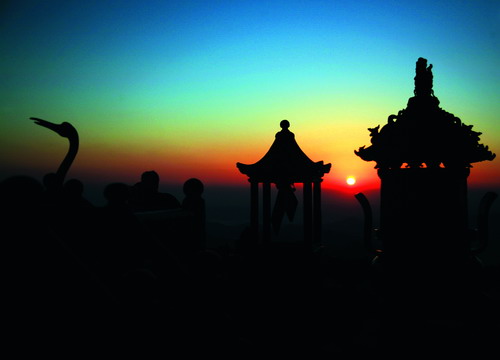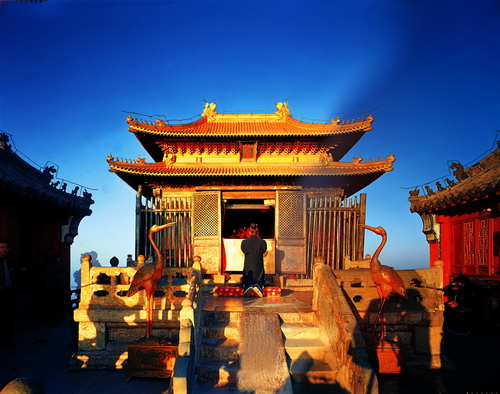Golden Summit Scenic Area
( chinadaily.com.cn )
 |
 |
| Taihe Palace (Photo by Yang Guangzhi) |
The Golden Summit Scenic Spot includes Golden Hall, Scripture Hall, Purple Gold City, Pilgrimage Palace, the Yuan Dynasty Bronze Hall and many other ancient buildings on the sacred road to Taihe Palace. Other historic sights are the Central Taoist Temple, the Yellow Dragon Cavity and the First, Second and Third Celestial Gates.
These buildings house many historical relics and treasures such as Taoist joss, altars, sacrificial vessels and musical instruments.
Golden Hall
 |
| The Golden Hall (Photo by Zhang Xing) |
The Golden Hall in Wudang Mountain is at the top of Tianzhu Peak, which is 1,612 meters above sea level. The construction of the palace was started in 1416 during the Ming Dynasty (1368-1644), and it features the largest extant brass cast building in China. The Golden Hall is 5.54 meters high, 4.40 meters wide and 3.15 meters deep. It is cast in brass and decorated with gold with a double-eaves roof. The ridge of the hall is decorated with vividly shaped gods, men, birds and animals. The hall has twelve stone lotus-based columns with elegantly structured brims and rafters. The crossbeams and the ceiling are carved with cloud patterns and spirals. The base of the hall is a stone platform made of granite rock and circled with engraved stone railings. All the josses, altars and sacrificial vessels are brass. In the center is enshrined the God Zhenwu, the Taoist god of Wudang Mountain. He is strong and tall with disheveled hair. He wears a gown and a suit of armor. Beside him stand the statues of a lovely boy and a pretty girl. On the two sides stand the statues of two brave generals named Water and Fire, which show the artistic essence of all the brass statues on Wudang Mountain.
The construction elements were produced in Beijing and then transported via China’s Grand Canal to Wudang Mountain and then installed. The Golden Hall was first cast in parts, which were then precisely riveted and welded together. Despite more than 500 years of natural erosion and occasional extreme weather, the palace is still in splendid condition. It is considered a pearl in the history of ancient architecture and casting technology in China.
In front of the Golden Palace, there are two bronze bell and chime pavilions built during the Jiajing reign (1521-1566) of the Ming Dynasty. They are still intact. On both sides of the palace, there are rooms for drawing lots and for deity seals. At the back of the palace is the Parents' Palace housing statues of Emperor Zhenwu's parents.
Along the mountainside under the palace lies a circular stone wall named Purple Gold City. Facing the cliff, the high wall is 1.5 kilometers long with four stone gates. The steepness adds to the impression of loftiness.
From Golden Hall, mountains green with forests can be seen. The Danjiang Reservoir appears to be as smooth as a mirror. The Taihe, Nanyan and Wulong palaces are positioned in order with a compact layout. Watching the sunrise in the morning and enjoying seas of clouds in the evening is like visiting a fairyland.
The legend of Golden Hall
According to legend, after the first Ming (1368-1644) emperor Zhu Yuanzhang fought with the then-ruling Yuan (1271-1368) army and failed, he escaped to a small hut at the foot of Wudang Mountain and met with Emperor Zhenwu, the Taoist god of Wudang Mountain, who transformed himself into an old Taoist. Zhu begged the Taoist to save his life. The Taoist said, "If I save you, the pursuing army will burn my hut. Where can I live?" Zhu replied, “If you save me and your hut is burned, I'll repay you with a golden palace in future.”
The Taoist agreed and made Zhu invisible by others using his magic power. The Yuan army didn't find Zhu and burned the hut. Zhu saw the hut burn, but he didn’t see the old Taoist t. He suddenly realized that the Taoist must be Emperor Zhenwu.
After taking the throne, Zhu forgot his promise about the golden palace. When he was old, Zhu dreamed that God Zhenwu came to him for the hut. Zhu asked his ministers and his descendants to build the Golden Palace for God Zhenwu. Zhu died before the palace could be built. Years later, Zhu Di, the fourth son of Zhu Yuanzhang, ascended the throne and built the Golden Palace.


